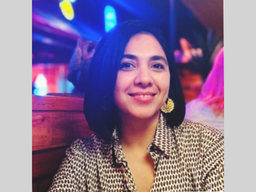Doctoral Dissertation Defense: Naghmeh Akhavan
Advisor: Dr. Brad Peercy
Location
Mathematics/Psychology : 412
Doctoral Dissertation Defense: Naghmeh Akhavan – Online Event
Date & Time
April 22, 2025, 12:00 pm – 2:00 pm
Description
Title: Mathematical Modeling of Border Cell Cluster Migration in Drosophila melanogaster
Abstract
Cell migration is fundamental to numerous biological processes, including development, wound healing, immune response, and cancer metastasis. This dissertation presents mathematical modeling approaches to studying border cell cluster migration in Drosophila melanogaster, with a particular focus on the role of tissue geometry and chemoattractant diffusion.
Initially, we employ a reduced 1D hybrid modeling framework to examine how extracellular structural features of the egg chamber influence chemoattractant distribution via reaction-diffusion equations and, consequently, agent-based border cell movement. Our simulations demonstrate that variations in geometry significantly modulate chemoattractant gradients: narrow regions amplify directional cues and promote faster migration, while larger extracellular volumes dampen gradients and reduce speed. We also find that increased chemoattractant concentrations can diminish migration due to receptor saturation, highlighting a non-monotonic relationship between signal strength and motility.
A key contribution of this work is the development of a predictive computational model that integrates chemoattractant diffusion, receptor dynamics, and force-based migration mechanics. By validating our simulations against experimental data, we establish a quantitative framework that captures the complex interplay between biochemical signaling and physical constraints in collective migration. Sensitivity analyses further reveal that alterations in tissue structure, such as genetic mutations affecting egg chamber morphology, lead to predictable shifts in migration dynamics.
Next, we develop a phase field modeling framework (system of coupled partial differential equations) for multicellular cluster migration within the 2D egg chamber geometry. A key innovation is the development of a novel Tangential Interface Migration (TIM) term, representing the climbing behavior of border cells as they navigate through the nurse cell environment. This term replaces the standard chemical gradient response with a more biophysically appropriate mechanism. Importantly, with the TIM force, cluster migration depends on the presence and alignment of neighboring cells, consistent with experimental observations that collective proximity is required for successful migration.
This study introduces phase field modeling as a novel approach to investigating border cell cluster migration, offering a significant alternative over traditional agent-based and continuum models. Unlike discrete methods that rely on tracking individual cells or simplified assumptions about the extracellular environment, the phase field method provides a continuous representation of the migrating cluster, naturally capturing dynamic shape changes, cell-cell adhesion, and interactions with tissue structure. By incorporating chemoattractant diffusion and receptor dynamics into this framework, we create a powerful and flexible tool that enables a more precise study of collective migration in structured environments.
In conclusion, this research advances our understanding of collective migration by integrating experimental observations with novel mathematical modeling. The insights into how tissue geometry and intercellular forces shape migration dynamics lay a foundation for future work in developmental biology, disease modeling, and therapeutic strategies targeting cell motility.
Tags:
